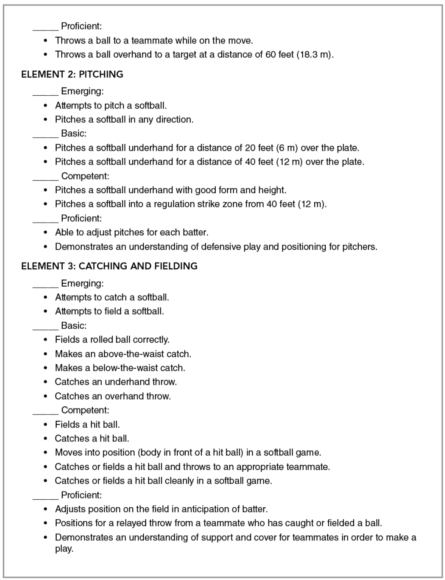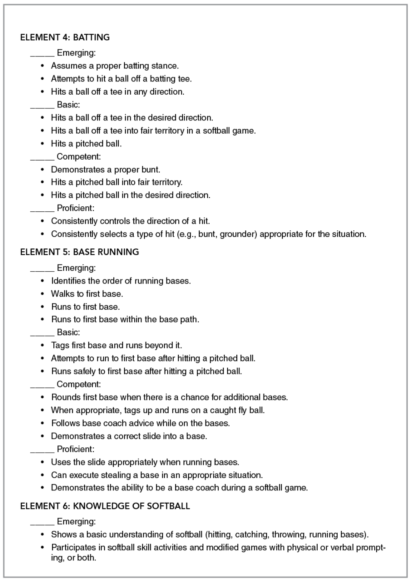Basic Skills Assessment
This is an excerpt from PE for Children with Moderate to Severe Disabilities by Michelle Grenier,Lauren J Lieberman.
Because adapted physical education is a service, not a placement, students such as Marin, whom we met at the beginning of this chapter, are often included in the GPE class even though they have unique needs and IEPs for physical education. For this reason, assessments that can accommodate all learners are very useful for teachers. The basic skills assessment (BSA), which was created by Kowalski, Houston-Wilson, and Daggett (in press),is ideal for use in inclusive physical education classes. The BSA was developed to assess a heterogeneous population of students - from those with severe disabilities to typically developing students - in a variety of curricular units. This curriculum-based assessment aligns with content areas taught in physical education programs.
The BSA example of softball in figure 3.4 is broken down into seven elements needed to participate in a game. Levels of performance are broken down into emerging, basic, competent, and proficient. Students are scored for each task; totals are matched to the scoring table to yield an overall picture of development. The BSA uses an Excel platformso that scores can be tallied for each level by indicating a 1 for each task completed. Then total scores are compared to the scoring table to obtain an overall picture of the student's current level of performance (emerging, basic, competent, or proficient).




Although some students with disabilities may never progress to competent or proficient levels of performance, they can be included in the testing protocol and helped to reach their highest potential based on the sequential aspects of the assessment.
Summary
All of the assessments presented in this chapter have one thing in common: They provide data on the motor performance and learning abilities of students who have traditionally been difficult to assess. These alternative assessments yield information on students' present level of performance that can then be used to determine their strengths and weaknesses, set goals, and plan instruction. Additionally, these assessments can be used to provide formative (ongoing) as well as summative (year-end) data.
Learn more about Physical Education for Children With Moderate to Severe Disabilities.
More Excerpts From PE for Children with Moderate to Severe DisabilitiesSHOP

Get the latest insights with regular newsletters, plus periodic product information and special insider offers.
JOIN NOW


